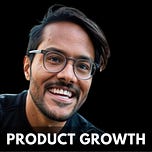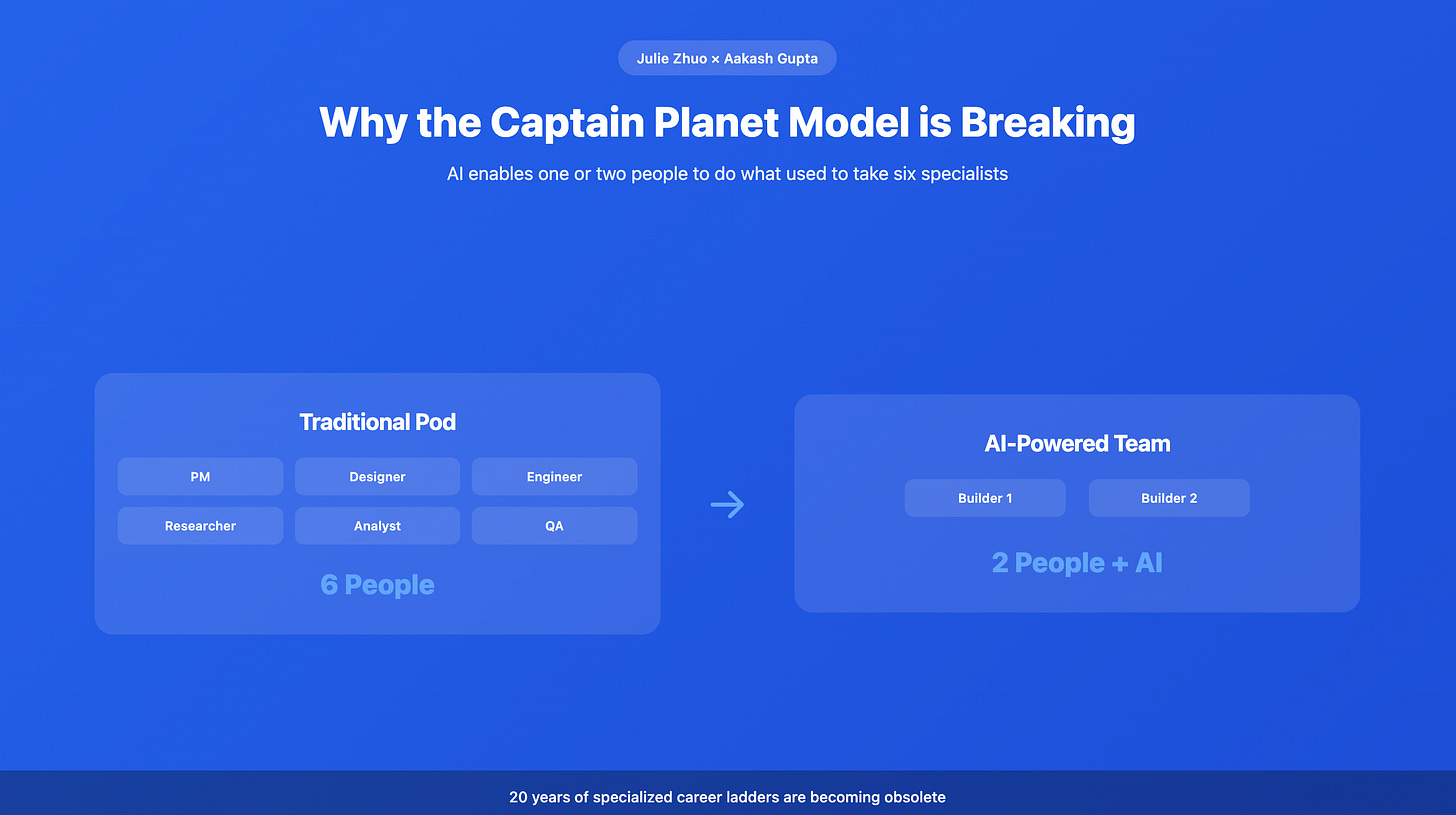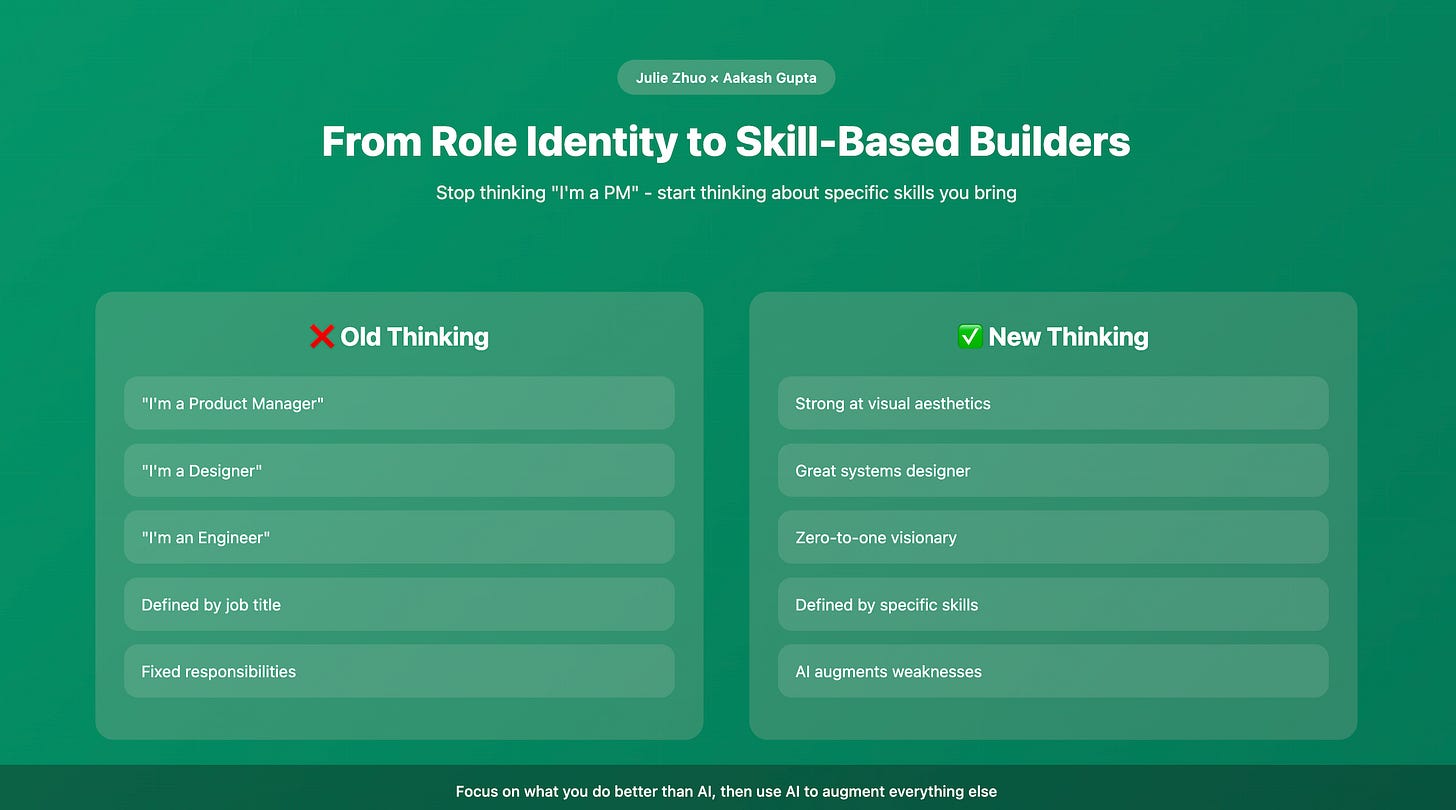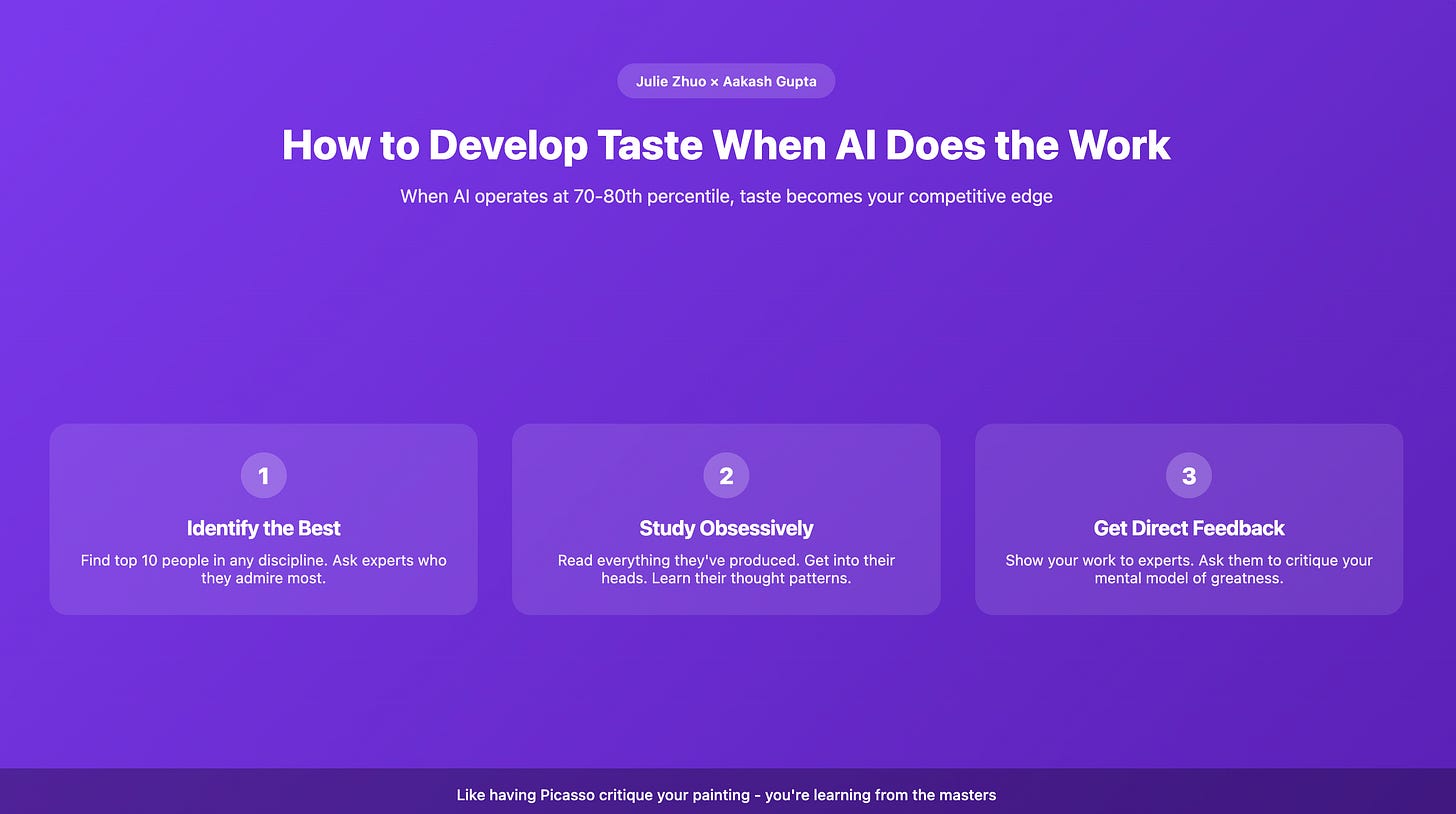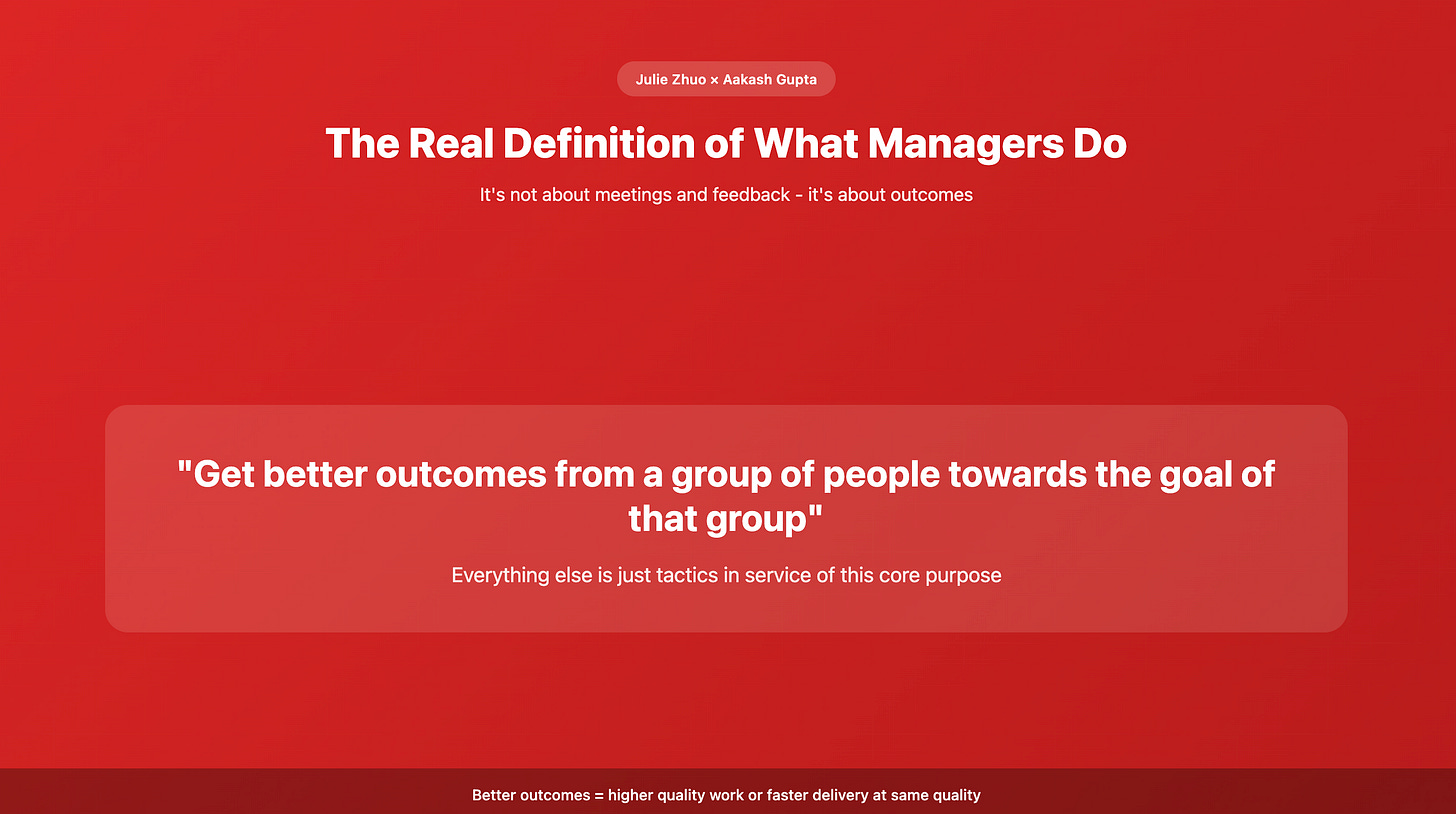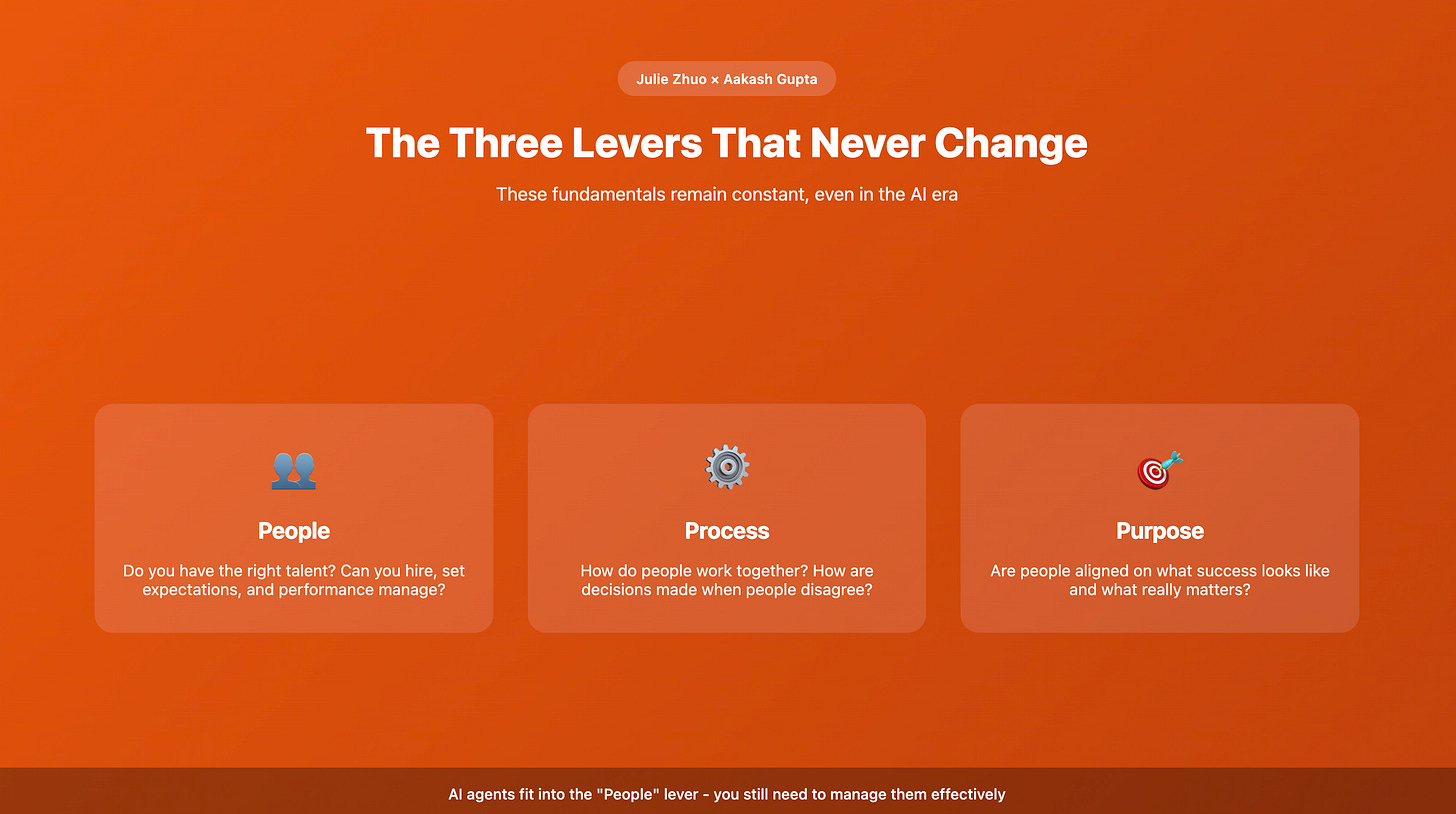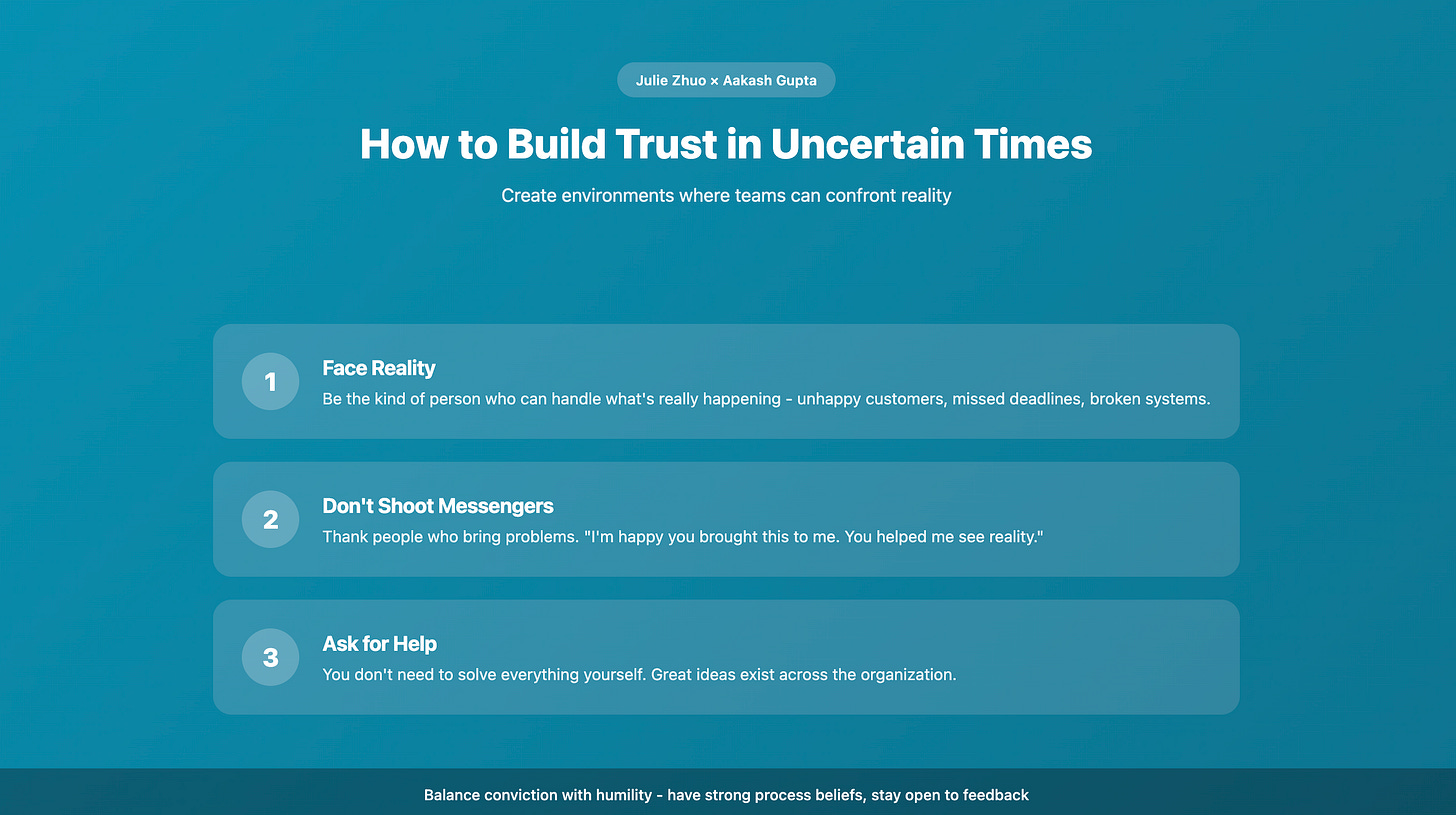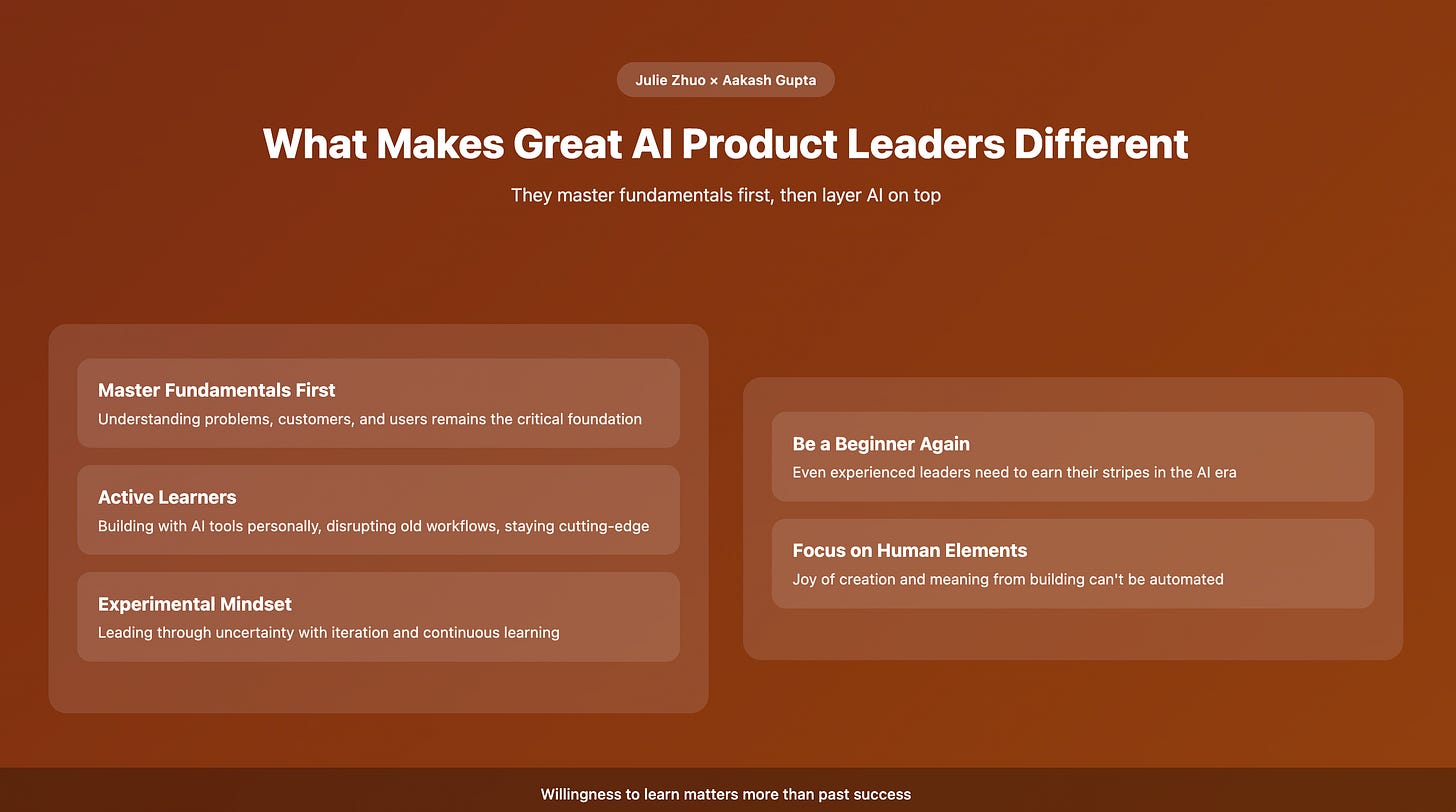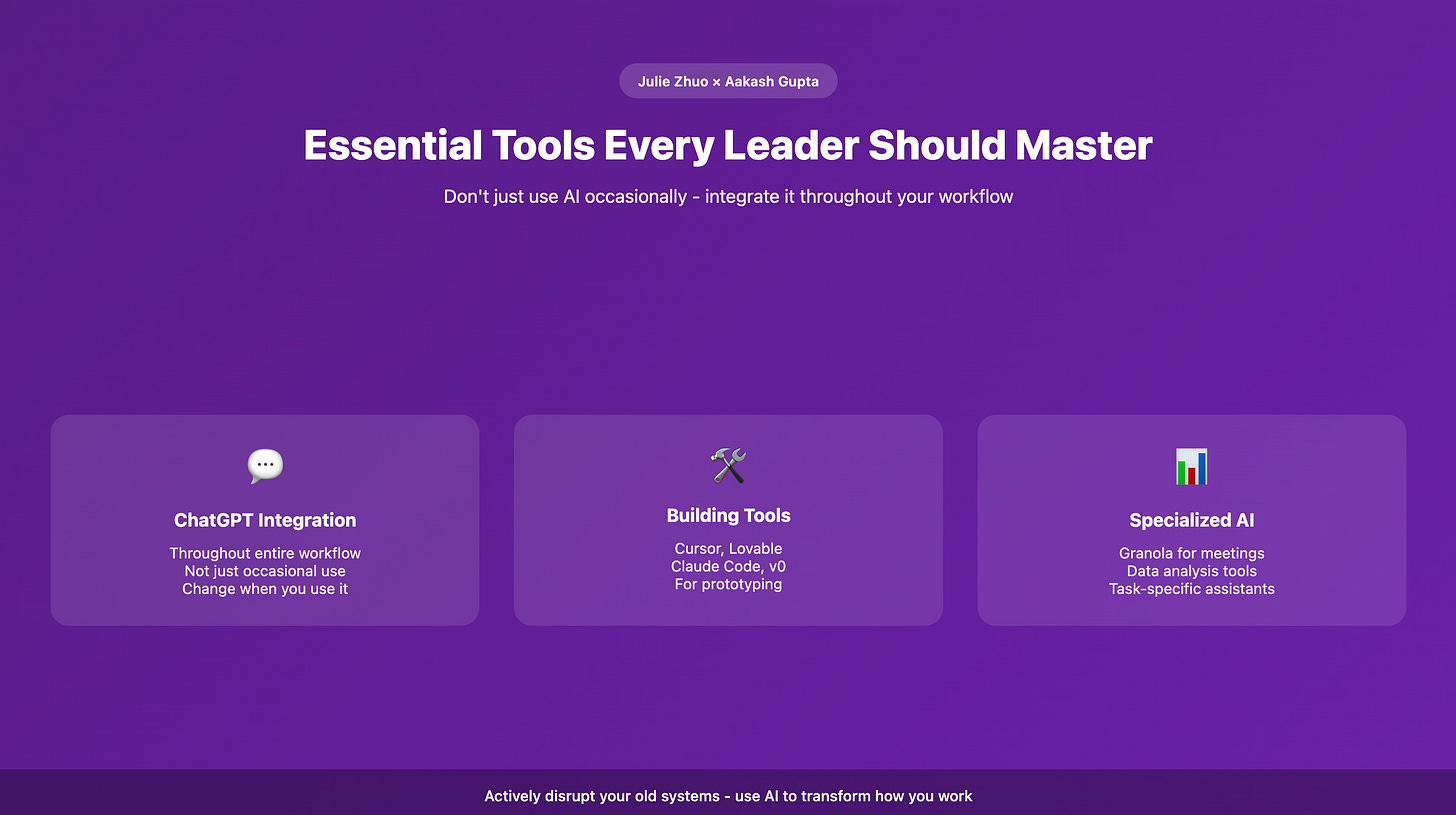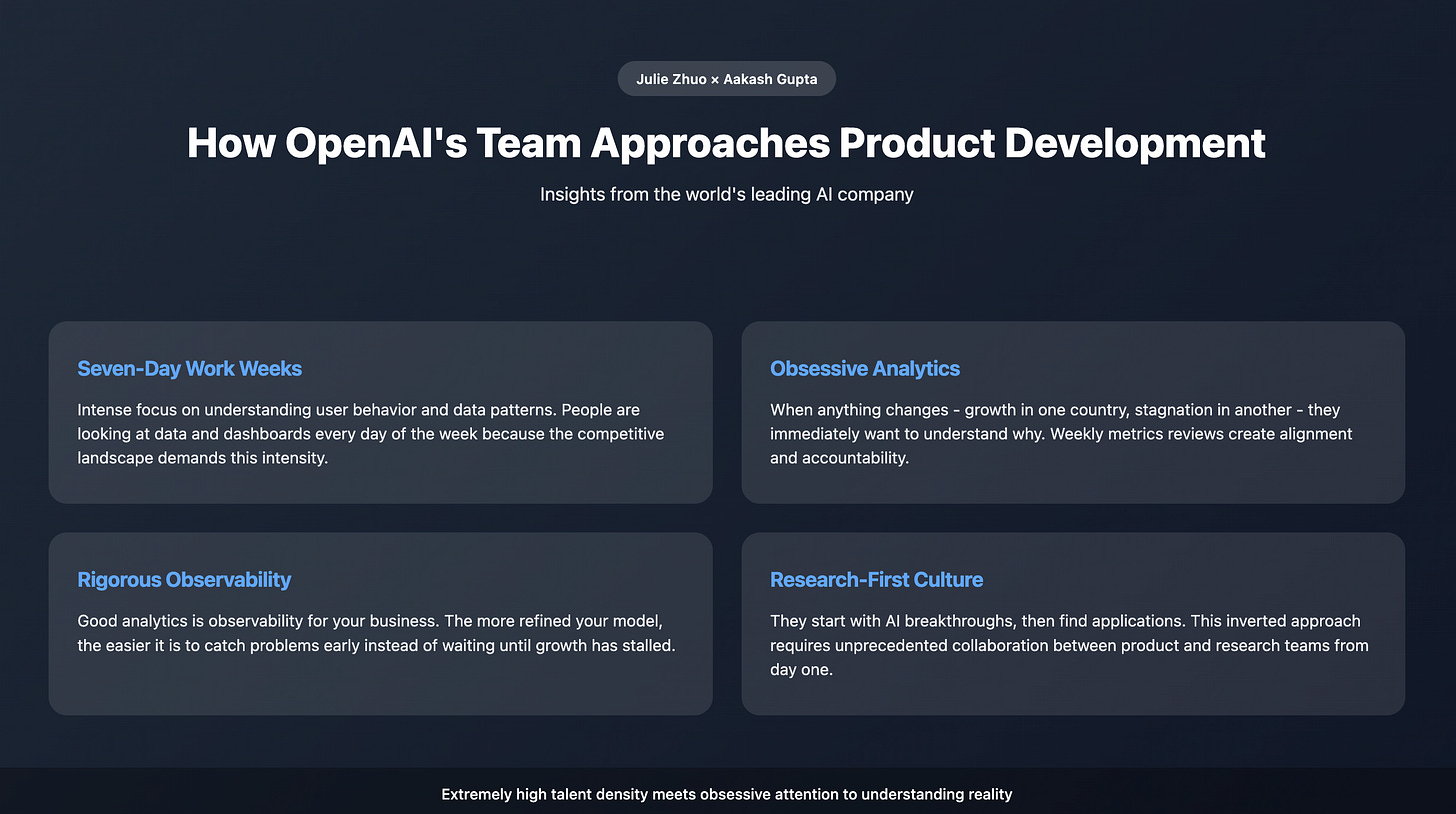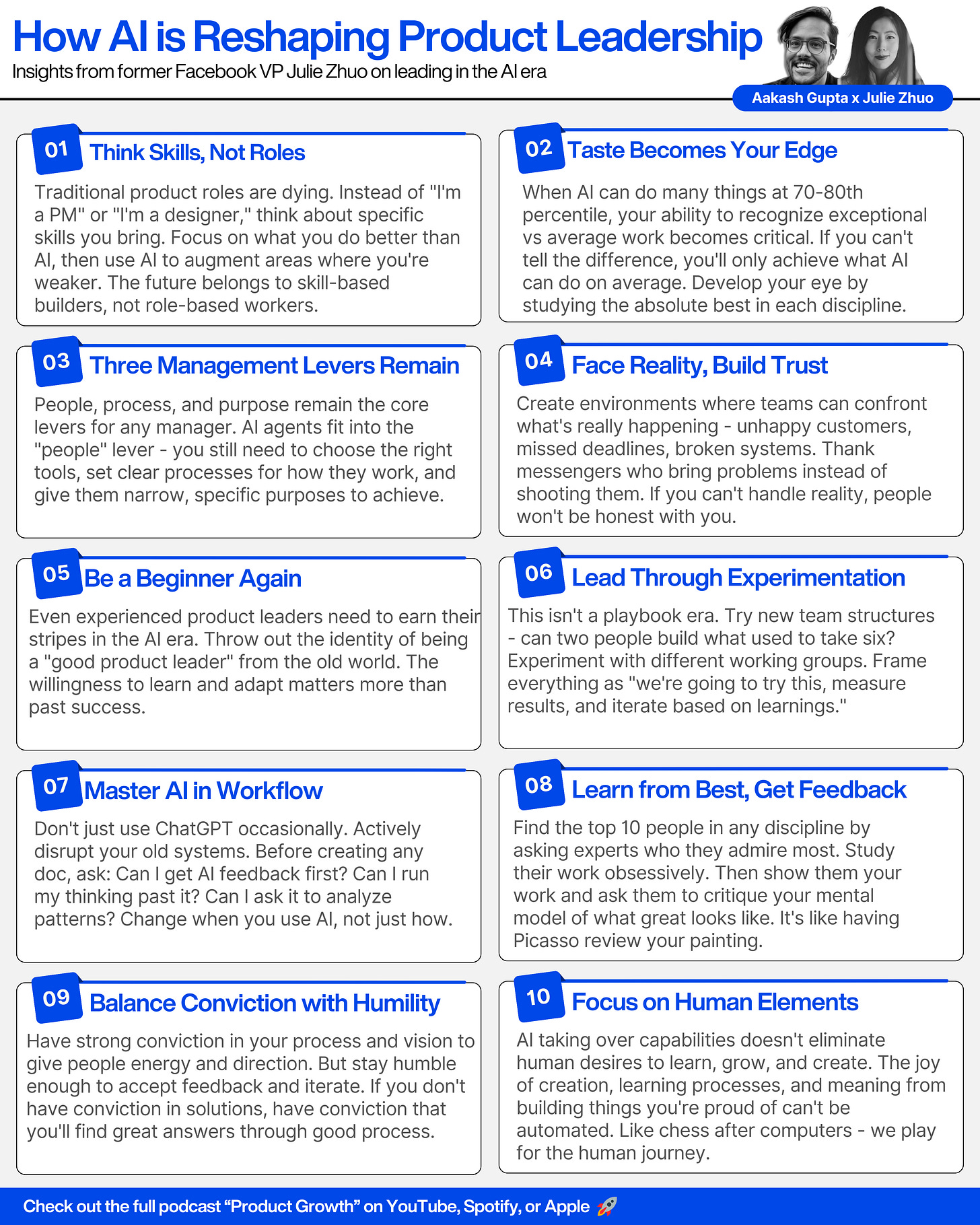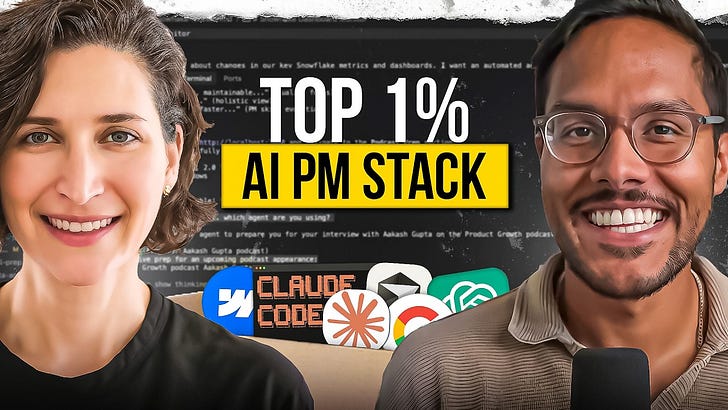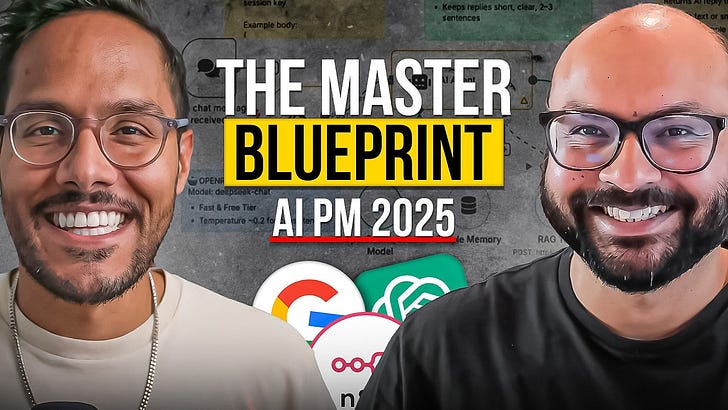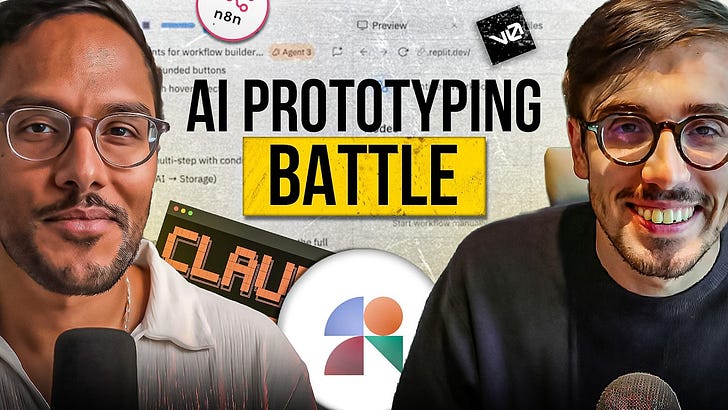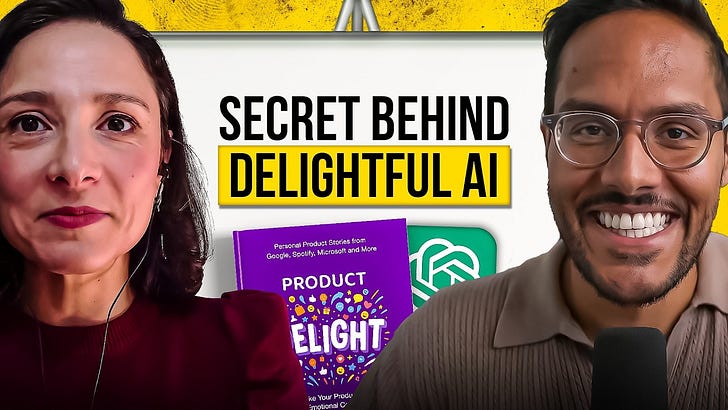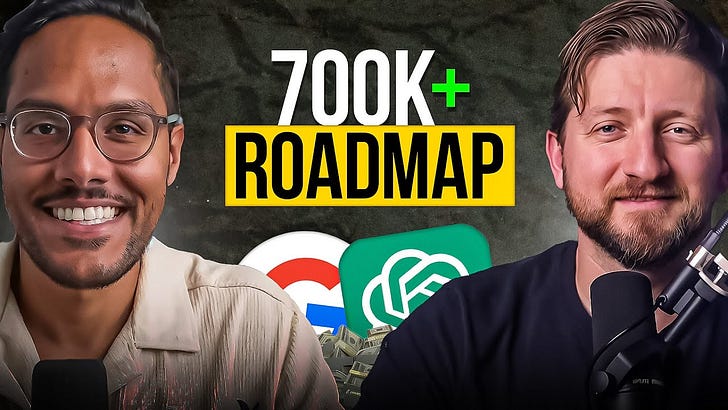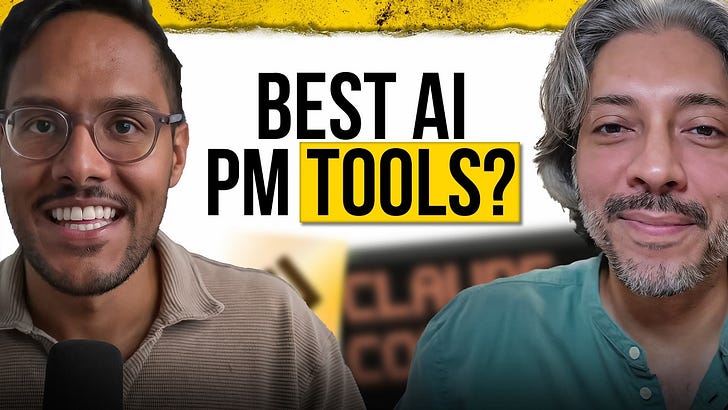Check out the conversation on Apple, Spotify and YouTube.
Brought to you by:
Jira Product Discovery: Build the right thing
Product Faculty: Product Strategy Certificate for Leaders (Get $550 off)
The AI Evals Course for PMs & Engineers: You get $800 with this link
Today's Episode
How does product leadership change with AI?
That’s the question we break down from every angle with today’s guest.
Julie Zhuo spent 13 years at Facebook, starting as an IC designer and rising to VP of Product Design. She wrote the Wall Street Journal bestseller "The Making of a Manager." Today, she's building AI products at Sundial and working with companies like OpenAI.
This is a special in-person episode that I shot in SF.
In our conversation, she breaks down:
How AI is Killing Traditional Product Roles
How AI Changs Product Leadership
How to Lead in the AI Era
(By the way, we’ve launched our podcast clips channel, so don’t miss out: subscribe here.)
Your Newsletter Subscriber Bonus
For subscribers, each episode I also write up a newsletter version of the podcast. Thank you.
We've put together the complete guide to thriving as an AI product leader:
The Future of the Product Trio with AI
How AI Changs Product Leadership
How to Lead in the AI Era
1. The Future of the Product Trio with AI
1a. Why the Captain Planet Model Is Breaking
The traditional product development model is dying.
For the past 20 years, we've built our industry around well-defined roles: product designer, engineer, product manager, researcher, data analyst. Julie calls this the "Captain Planet model" - representatives from each discipline come together to form a pod that creates products.
This worked when building was hard and required specialized skills.We invested heavily in career ladders for each discipline. We created clear industry standards for what makes a junior designer versus a senior designer versus a principal designer. The same for engineering and product management.
AI changes everything. As Julie puts it: "The whole promise of what AI enables is that each individual person can do more than they've ever been able to do before."
AI handles the lower-level manual work. It helps with higher-level ideation. Every six months, we see new models that are smarter and more capable.
The math is simple: If one or two people can build what used to take six people, we don't need six distinct roles anymore.
This creates the existential crisis every product person is facing: Will my role exist in 10 years?
1b. From Role Identity to Skill-Based Builders
Julie's answer is counterintuitive: Stop thinking of yourself as a predefined role.
"Let's not think of ourselves as these predefined roles. Let's just actually think of ourselves as builders."
This mental shift is harder than it sounds. When we start our careers, we want to glom onto something. Julie remembers joining Facebook's frontend engineering team (which was also the design team) and asking: "What does it mean to be a designer? What does it mean to be a good designer?"
We all want to learn a craft and feel like we know what our lane is.
But this moment calls for separation from those lanes. Instead of thinking "I'm a product manager," think about specific skills and experiences:
This person is strong at visual aesthetics and craft
This person is a great systems designer
This person is a wonderful zero-to-one visionary
The same is true for PM and engineering. Rather than role-based thinking, focus on:
What skills do you bring that are much better than average?
What skills are you lacking that you can augment with AI or other people?
How can you use your strengths to direct AI effectively?
1c. How to Develop Taste When AI Does the Work
The critical skill becomes product taste or product sense.
When AI can do many things at an average-to-good level, the difference between great work and average work comes down to knowing whether the AI is producing exceptional or mediocre output.
If you don't know because your eye isn't well-trained, you can only expect to do the average of what AI can do.
Here's Julie's system for developing taste:
Step 1: Identify the Best "Go and figure out who are the absolute best. It's much easier these days. You can go on Twitter and you can probably figure out who are the best designers on Twitter."
Tactical approach: Ask any designer for their top 10 admired designers. Then ask each of those 10 for their top 10. Eventually, you'll see patterns and convergence on who's truly exceptional.Step 2: Study Their Work Obsessively Read everything they've produced. Get into their heads. Look for how they see the world, how they think, how they understand their craft.
Step 3: Get Direct Feedback Show your work to these experts. Come prepared with your mental model of what great looks like and ask them to critique it.
Julie recently did this for marketing: "Here's my mental model of what great marketing looks like if I were to hire someone for this role. What do you think?" The expert completely critiqued her mental model, giving her a more refined understanding.
This is like having Picasso critique your painting. You're not just studying the master - you're showing them your work and learning from their feedback.
2. How AI Changs Product Leadership
2a. What a Manager's Job Really Is
Most people think a manager's job is tactical: have meetings with reports, share feedback, figure out promotions and firing.
Julie's real definition: "Get better outcomes from a group of people towards the goal of that group."
This is contextual. If you're a superintendent for a school district, your goal is the highest quality education for each child. Your job as a manager is to use your levers to get everyone on the staff working together to achieve better outcomes than you would get without you there.
There are three levers managers have:
People: Do you have the right people? Can you hire great talent, set expectations, create role definitions, and performance manage (including firing when necessary)?
Process: How do people work together? When two amazing people disagree, what happens? How do you make decisions? What are the norms around how work gets done?
Purpose: Do you have a clear picture and vision? Can you get everyone aligned on what you're really trying to do together?
All tasks are in service of using these three levers to drive outcomes. Outcomes boil down to two things: doing things at higher quality or doing things faster at the same quality.
2b. How AI Changes the Three Levers
AI agents fit into the "People" lever. You have to pick the right tools or models with the right skill sets for your purpose.
Process becomes even more important. Prompt engineering and directing AI is similar to managing humans. When you have someone early in their career, you break down complex tasks into smaller tasks they can execute effectively. The same applies to AI agents.
Purpose matters more than ever. LLMs need narrow, clear purposes. You need to tell them the outcome first, then the process of how they should work.
Some agents are 100x more expensive than others, creating the same cost dynamics as hiring decisions with humans.
2c. Building Trust in Uncertain Times
The most important ingredient for any team is trust. But how do you create an environment where people feel safe bringing problems to you?
Step 1: Face Reality "You want to be the kind of team where we can confront reality."
Reality is what's really happening on the ground - customers who don't love what you're building, teams that won't hit deadlines, systems that aren't working.
If you hold too tightly to an ideal vision and aren't open to reality, people won't feel they can be honest with you.
Step 2: Don't Shoot the Messenger When someone brings you bad news, your response sets the tone for everything. If you take it out on the messenger ("Why did you tell me this? Go fix it!"), people learn to hide problems.
Instead: "I'm really happy that you brought this to me. You helped me see reality. I appreciate people like you. I hope you do that more often. Now help me figure out how we're going to resolve this together."
Step 3: Ask for Help You don't have to come up with every solution. Great ideas exist across the organization. Your job is to curate ideas and invite everyone to be part of the solution.
The key is finding the balance between conviction and humility. You need enough conviction in the vision to give people energy and direction. But too much conviction makes you brittle and closed to feedback.
Julie's solution: "Even if I don't have conviction in any solution, I can often have a lot of conviction in a process." If you understand the problem deeply and can iterate quickly, you'll eventually find great answers.
3. How to Lead in the AI Era
3a. What Makes Great AI Product Leaders Different
They master the fundamentals first. Understanding the problem, the mission, the customers, the users - these core principles remain true. You can't be a great AI product leader without being a great product leader.
They're active learners at the cutting edge. "If you don't understand where technology is today, it's very hard to say that you're a great product leader in the age of AI."
This means:
Building things with AI tools personally
Using the tools in your daily workflow
Being the first to switch your habits
Actively disrupting your old systems of working
Julie admits: "I have a very traditional way of writing because I love writing. But the world is changing. I need to actively disrupt how I go about writing even though that's something I felt I was getting reasonably good at."
They lead through experimentation. This isn't a time when anyone can give you a playbook. Everyone has to try things, see how they work, and iterate.
Questions to experiment with:
Could two people work on something and ship it end-to-end instead of requiring a full pod?
How should we structure working groups differently?
What new mental models do our teams need?
They embrace being beginners again. "We're all beginners here again. Let's throw that identity of being good product leaders out the window. Are we actually good product leaders in this new era? I don't know. I think we have to earn that."
3b. Essential Tools Every AI Product Leader Should Master
Start with ChatGPT integration throughout your workflow. The key isn't the specific tool - it's changing when you use it.
Instead of creating a doc the old way, ask yourself:
Can I get feedback from ChatGPT first?
Can I run my high-level thinking past it and ask it to poke holes in my assumptions?
Can I ask it to analyze patterns in emails or other data?
Julie's current AI toolkit:
For Building: Cursor, Lovable, Claude Code, v0 - she tries different tools for different tasks to understand their strengths and weaknesses
For Meetings: Granola for meeting notes and summaries
For Data Analysis: Sundial (her own tool) for customer and sales analysis
For Personal Development: Limitless Pendant - a clip that records audio and gives feedback. Julie uses it at home and it gives her parenting insights like "maybe you should let your kids talk more because you cut them off."
The pattern: Try as many tools as possible. Treat it like interviewing candidates - you want to understand the strengths and weaknesses of different options.
3c. What You Can Learn from OpenAI's Product Team
Julie works with OpenAI through Sundial and has unique insights into how the world's leading AI company approaches product development:
They work seven days a week. People are looking at data and dashboards every day of the week. The competitive landscape demands this intensity.
They have obsessive attention to understanding reality. When something changes - growth in one country, stagnation in another - they immediately want to understand why. Not just surface-level metrics, but the deeper explanation of human behavior and customer patterns.
They maintain rigorous hygiene around metrics reviews. Weekly reviews where leaders examine KPIs and dashboards together. This serves three purposes:
Creates alignment - everyone has the same understanding of how the business is performing
Builds accountability - if your area went down, you're expected to know why
Establishes shared language - common terminology and understanding that teams can take back to their organizations
The principle: "Good analytics is observability for your business. The more refined your model, the easier it is to catch problems early instead of waiting until growth has stalled."
You may like our episode with OpenAI’s Head of Integrity Product if you enjoyed this.
Key Takeaways
Where to find Julie Zhuo
Related Content
Podcasts:
Newsletters:
P.S. More than 85% of you aren't subscribed yet. If you can subscribe on YouTube, follow on Apple & Spotify, my commitment to you is that we'll continue making this content better.

